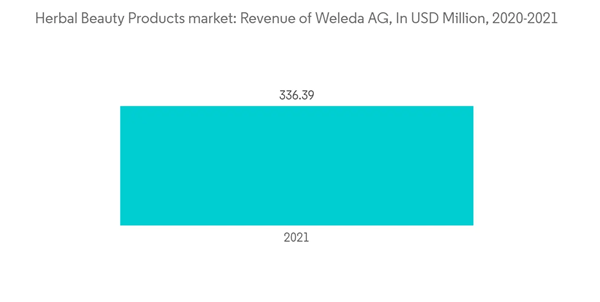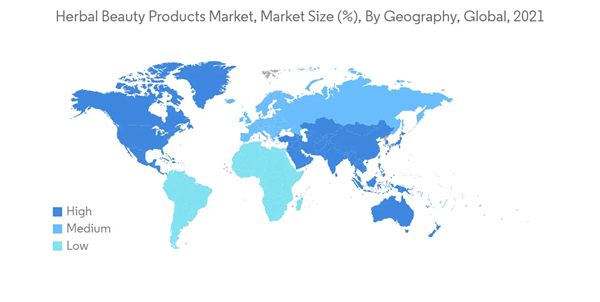The Herbal Beauty Products Market size is estimated at USD 111.11 billion in 2024, and is expected to reach USD 155.11 billion by 2029, growing at a CAGR of 6.90% during the forecast period (2024-2029).
This product will be delivered within 2 business days.
Key Highlights
- The inclination toward enhanced appearance and looks combined with increased adoption of herbal products among consumers are anticipated to benefit the expansion of the herbal beauty products market across the global market in the forecast period. There is an increasing demand for herbal beauty products, owing to the rising consumer awareness regarding the harmful effects of the chemical added to beauty products.
- Moreover, beauty companies have been acquiring herbal beauty and personal care brands to expand the consumer base who are progressively passionate about clean, green, and herbal products. The demand for herbal beauty products is anticipated to be driven by the rising usage of cosmetics containing organically derived herbal compounds like lavender, chamomile, rosemary, jojoba oil, Aloe Vera, etc., to treat skin, acne, and hair issues.
- Because herbs frequently have strong antibacterial and antioxidant effects and provide pigmentation inhibition, herbal extracts are primarily incorporated into beauty products. Additionally, herbal ingredients that protect skin from UV rays and pollution include vitamins, witch hazel, willow herb, green tea extract, and botanical extracts. All of these factors will increase the demand for herbal beauty products.
Herbal Beauty Products Market Trends
Popularity of Cruelty-free Beauty Products to Drive the Herbal Beauty Products Market
- The growing preference for chemical-free products and the rising popularity of environmentally-sustainable products are driving the demand for herbal beauty products worldwide. The increased demand for chemical-free hair and skin products and growing awareness about cruelty-free cosmetics products support market growth.
- The significant rise in the influence of social media and beauty blogs that are communicating the benefits of herbal beauty products is likely to influence sales of herbal beauty products. Animal experimentation impacts consumer choices as social media is filled with virulent discussions against animal cruelty. Customers are fearless in publicly supporting some brands while criticizing those that don't adhere to their ethical standards.
- Moreover, herbal beauty products are suitable for all types of skin, which influences the sales of herbal beauty products such as foundation, eye shadow, and lipstick which are appropriate irrespective of skin tone. The availability of various herbal beauty products and improving distribution networks are pivotal in driving the market growth.
Asia-Pacific is the Fastest Growing Market
- The herbal beauty products market is expanding in Asia- Pacific primarily due to numerous safety regulations, increased consumer awareness, and customers' willingness to pay a high price for quality herbal products. The consumer inclination toward healthier lifestyles and the growing demand for products with low environmental impact drive market growth. Furthermore, the increasing acceptance of vegan lifestyles among millennials will likely contribute to the market's growth.
- Also, the increasing popularity of traditional Chinese ingredients in skincare products is aiding the market growth among domestic consumers. Natural ingredients have become the top priority and concern in China.
- With the growing popularity of organic products, players are developing products with exotic ingredients. For example, facial masks that contain snail cream from China are gaining extreme popularity. Face masks incorporating healing and anti-aging properties and organic ingredients, such as argan oil serum, green tea extract, and Vitamin C, are also gaining popularity.
- The key players are focusing on the environmental dimension of their strategies by creating sustainable partnerships with local vendors or providing information to their consumers about the origin and quality of their raw materials to meet consumer expectations. This approach is not only for procurement practices but also for packaging, which will change the market dynamics of the herbal beauty products market in the upcoming years.
Herbal Beauty Products Industry Overview
The herbal beauty products market is fragmented, with presence of numerous players competing for major positions in the market. Some prominent players in the market are Arbonne International LLC, Weleda AG, Dr. Hauschka, Herbline, and Himalaya Herbals. The key players are adopting various strategies such as expansion, mergers and acquisitions, partnerships, and new product development to meet the growing demand. For instance, in November 2021, Björk and Berries firm launched Faviken Bath Salt, which is prepared with hand-picked herbs and flowers from gardens in Northern Sweden. It is described as being calming. The purifying properties of birch, the calming effects of lavender, and the calming effects of chamomile flowers are said to be added to this botanical bath salt, which is produced with flowers and herbs.Additional Benefits:
- The market estimate (ME) sheet in Excel format
- 3 months of analyst support
This product will be delivered within 2 business days.
Table of Contents
1 INTRODUCTION
4 MARKET DYNAMICS
5 MARKET SEGMENTATION
6 COMPETITIVE LANDSCAPE
Companies Mentioned (Partial List)
A selection of companies mentioned in this report includes, but is not limited to:
- Himalaya Global Holdings Ltd.
- Arbonne International LLC
- Marc Anthony Cosmetics Inc.
- Weleda AG
- Herbline
- Dr. Hauschka
- Grown Alchemist
- Estee Lauder Companies
- Tata's Natural Alchemy LLC
- AIMIL Pharmaceuticals
- Lotus Herbals pvt. Ltd.
Methodology

LOADING...










